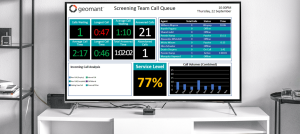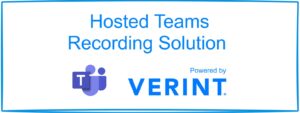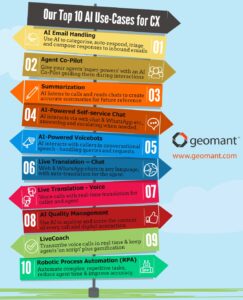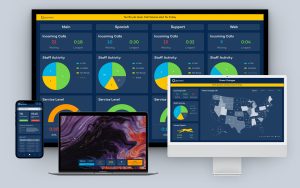As Microsoft Teams becomes the dominant force for workplace collaboration, with 75 million active users and counting, more and more organizations are looking to move all their internal comms capability into the system for seamless interaction.
Direct routing solutions that add full internal and external voice to Teams are often the first port of call for many organizations. These are increasingly being paired with multichannel contact center solutions such as Buzzeasy Contact Center for Teams, to transform Teams into a true UC platform by enabling users to handle customer interactions across multiple channels including voice, email, webchat and the most popular messaging platforms.
Whatever stage of the Teams adoption journey you are at, sooner or later you may need to consider recording. For those working in regulated industries, such as financial services, compliance will be at the forefront of decision making. However, you may simply want a recording solution to enhance your quality and training programmes. The beauty of Microsoft Teams is that extra functionality can easily be added, allowing your organization to run more efficiently and in new and innovative ways.
OK, so you’re thinking of increasing your organization’s capability by introducing Teams Recording. What questions do you need to ask yourself before jumping in?
What type of recording am I looking for?
First, you need to understand the difference between convenience recording and compliance recording.
Call recording has been a native feature of Teams for some time, but up until now this has only been what is known as ‘convenience recording’. This is essentially a user-activated feature that is just designed for personal record keeping and absent meeting attendees.
But what about regulated industries where all calls must be recorded and stored securely for a number of years? This process can be termed as ‘compliance recording’ and Microsoft has recently opened up an API to offer this service.
One of the main differences with compliance recording is that it is set at a system level and does not have to be user activated and in fact more crucially it cannot be disabled by users. This ensures that no recordings are missed and can all be channelled to a secure, searchable storage location of the organization’s choosing.
When operating in a regulated industry particularly, you should consider choosing a recording solution that has been subjected to the rigorous field trials, as this provides additional reassurance. The Geomant solution uses software from global specialist Verint and this has provided the opportunity to thoroughly test and ensure the robustness of the product before going to market.
Do you understand your objectives and obligations when it comes to call recording?
Before you jump in and start looking for a recording solution, you need to understand the level of compliance that you must adhere to. This will depend, to some extent, on the sector in which you work: in financial services, healthcare, energy and utilities, and other highly-regulated sectors, you will need to retain communication records and securely manage your data.
To fulfil these responsibilities, you’ll need a recording system that stores data for the necessary retention period and can also retrieve, replay, and analyse it whenever the need arises.
Of course, you may also want to implement recording of your team’s communications with customers for quality and training purposes. And, if you work in one of the less regulated industries, this may be your only consideration.
Do you work in financial services?
Of all sectors, the financial industry is regulated by some of the strictest compliance obligations. Ever since the financial crisis of 2008 regulators have introduced increasingly tighter rules, such as MiFID II.
MiFID II applies to financial services businesses operating anywhere in the EU and many non-EU-based institutions that trade with European clients and entities. The legislation demands that you retain voice and electronic communications records, surveillance and reporting for all your trading activities, while also ensuring that these records are of the highest level of quality.
This is a tough ask, but a solution like Geomant’s Recording for Teams can give your compliance, risk and IT teams peace of mind that interactions are automatically captured, processed, stored and are readily available to authorized users, when needed. As a result, non-compliant activities such as market abuse and insider trading are now considerably easier to detect.
What do I need to record? Call recording vs interaction recording
Once upon a time, the way we all communicated with organizations was with a simple voice call.
Multi and omnichannel customer experience strategies now offer customers the opportunity to speak to organizations via options such as instant messaging and video. When looking for a solution, you really need to go for one that is capable of recording as many different kinds of interactions as possible, as people are likely to be collaborating with your organization in multiple ways.
Audio recording may not be enough, as it would be all too easy for an operator to hold up a hand-written sign on a video call, or use emoticons/emoji in a chat conversation to get a non-compliant message across.
Better still, choose a solution that provides recording features regardless of the endpoint. This is particularly beneficial if your organization has remote operations. Your choice should also work with any operating system or device used by a regulated user: desktop, web and mobile clients, virtual consults, conference room endpoints, IP phones and other Teams enabled devices.
Will your solution enable you to respond to a compliance request quickly and easily?
If you have a compliance request or are involved in an investigation, having the recordings will not be sufficient for the authorities. You need to be able to locate and safely retrieve the required information.
A unified system that captures all the communication channels used will help simplify data management by providing a single, easily searchable repository for all recorded media and metadata. This speeds up the retrieval and analysis of conversations in the context of other channels the regulated employee may have used.
How can I tap into unparalleled security and resilience?
To deliver continuous data capture, a Teams compliance recording solution needs to offer many different types of resilience that will ensure recording is successful, even during a server failure.
Geomant’s solution provides this and more. You can even apply role-based access control, authentication workflows, and encrypt and digitally sign the recorded data. This will stop your communication records being accessed by non-authorised parties, ensuring that the integrity of the captured media and metadata remains trustworthy.
Another important feature is having the flexibility to keep an audit trail beyond the Office 365 standard retention period, and then being able to search for and export these records into your internal systems for risk management or auditing later.
How do I get the full value from my recorded data?
Geomant’s Teams recording service enables granular management of retention policies across different modes of Teams communications channels. This means your entire environment will comply with the regulations governing record-keeping. It also helps ensure that all records are deleted or archived once the required retention period has elapsed.
Make sure the solution you choose for Teams and UC recording creates meaningful efficiencies for compliance officers, surveillance analysts and IT Professionals, alike. Data discovery and analysis and other time-consuming tasks will be considerably easier if your recording platform unifies search and playback, data export, voice transcription, automated call categorization, compliance workflows and reporting in a single easy-to-use application.
Your Teams recording solution will also need to dovetail with your broader compliance technology environment. Instead of creating blockages, it needs to make it easy to retain and migrate your gathered data without compromising its usability. By adopting open standards and using open APIs, everything can work seamlessly together with external systems to leverage the data that’s stored in legacy systems.
Are you keeping one eye on the future?
Whether you’re looking for a recording solution for compliance, training or quality purposes, it’s important to choose one that has the flexibility to scale.
Traditionally a call recording solution would have been deployed locally with all the physical lines in the building tapped to record onto an on-premise solution. Now, the changing world of work, accelerated by the COVID-19 pandemic, means that you may well have people working in multiple locations on multiple mobile devices.
All these workers may need to be recorded to maintain compliance, mitigate risk and offer best practice recording for ongoing training. The nature of the interaction recording solution has had to change to meet this new challenge and, thankfully, products like Geomant’s fully-hosted cloud-based Verint solution have all the capability required.
Deployment Model: Cloud or Hybrid?
Recording solutions like Geomant’s are able to support your specific business needs and, at the same time, will avoid causing an unnecessary deployment headache for your overworked IT department.
With previous on-premise solutions, there was a requirement for physical infrastructure in your building, but this is no longer the case. Microsoft’s third-party focused recording API ensures that set-up can be managed at a policy level within Teams to point at the relevant services.
The system can be deployed in the client’s cloud environment, on the client’s premises or within our Azure environment. (It offers full integration with Microsoft Azure Virtual Servers, Azure Active Directory, Azure SQL Database, Azure Storage and more.)
A purely cloud-based solution makes implementation easy and gives you flexibility, scalability and a lower total cost of ownership (TCO). This eliminates the infrastructure and expense associated with legacy hardware-based solutions and requires no additional technology overhaul for your business. Better still, certain vendors support end-users and UC service providers with a multi-tenant model to benefit from lower provisioning costs, easy maintenance and resource efficiency.
As well as saving you money, it also means that, for a straightforward mid-size Teams-only organisation, the bulk of the work can be done in hours, not weeks. For more complex organizations, this will take a little longer, but the flexibility exists to make the solution fit into any storage or infrastructure dictated by the client, inside or outside of Microsoft.
You may want to keep part of your deployment on premises, if you decide to store your recorded data in a media repository within your existing IT environment. This gives you greater control over the data and enables seamless integration with other on-premises archives and server platforms.
On the other hand, a purely cloud-based solution – hosted on your own Microsoft Azure tenant or via a hosting partner – delivers simplicity, flexibility, scalability and cost-efficiency. This eliminates expense associated with legacy hardware-based solutions and requires no infrastructure changes for your business.
How will my chosen recording solution fit into my other systems?
While we’re seeing an ever-growing trend towards Teams-only comms environments, you would be well advised to select a recording solution that can work in multi-vendor environments and integrate with existing systems.
That will allow you to capture legacy PBX, mobile and other recordings in the same place. The key to your success here is teaming up with a capable and experienced partner, such as Geomant. We can work on the system’s architecture to bring this all together for you.
Using a single solution to record all Teams interaction streams, alongside other communications environments, can help your business reduce the hardware footprint, technical infrastructure, IT workload and operating costs.
How do I find out more?
Geomant’s fully-hosted Verint solution has been generally available since 19 May and we will see more channels added for recording in the next month or so.
Why not watch the video or download the factsheet to discover more or book an appointment with a member of our helpful team?
{% video_player “embed_player” overrideable=False, type=’scriptV4′, hide_playlist=True, viral_sharing=False, embed_button=False, autoplay=False, hidden_controls=False, loop=False, muted=False, width=’1920′, height=’1080′, player_id=’29968851951′, %}












